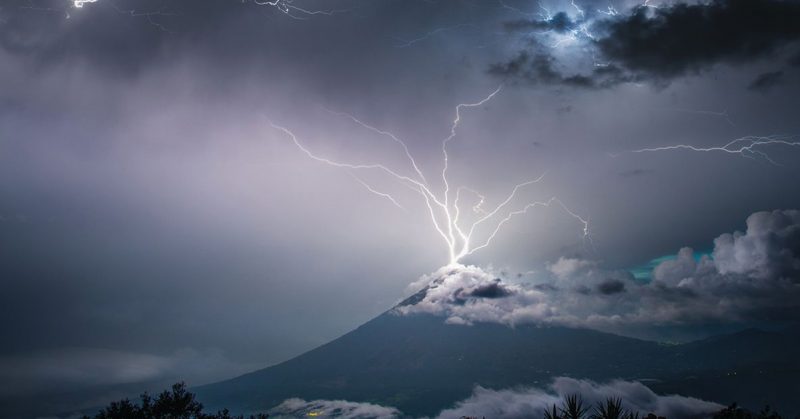In 2019, a photographer in Guatemala captured a once-in-a-lifetime shot of a powerful bolt of lightning striking the top of a volcano just as it erupted. [1] Sergio Montúfar, an astrophotography expert, had been at the Volcán de Pacaya in Villa Canales that night to capture the incredible lava beds. The weather had been gloomy but he hadn’t been expecting a full-blown raging storm. Luckily, the volcano was also erupting that night.
“I was there to do astrophotography of Volcán de Pacaya which has rivers of lava, I wanted to get the Milky Way over Volcán de Pacaya but the terrible storm didn’t let me,” he recalled. “We expected clear skies, but that never happened and we got caught by the rain.”
The rain was a glitch in his plan but he hadn’t climbed all that way to go home with nothing. Montúfar continued capturing the horizons until the incredible scene flickered by.
“I have never seen so many lightning strikes coming from the top of Volcán de Agua,” he added, noting the event was “life-changing.” “It taught me not to be negative under some situations because I was angry about the storm, but I never expected it to be this amazing storm.“
Montúfar’s photo is not exactly “volcanic lightning”
The photo above could easily be misinterpreted as volcanic lightning, a phenomenon where lightning bolts are created by a volcano rather than electrons in the atmosphere.
Volcanic lightning is not caused by seismic or tectonic activity below the earth’s surface. Scientists believe it’s caused (or assisted) by the change in density between the inner enclosure of the volcano and the atmosphere just above it. Volcanic lightning only forms within a volcanic plume, the densely thick cylinder of smoke that’s emitted from an erupting volcano. Volcanoes that emit more lava than ash plumes are less likely to have the lightning effect.
The thick plumes are made of very tiny gaseous particles tightly compressed beneath the volcano. As they escape from the opening to the atmosphere, the density decreases and this change contributes to the lightning phenomenon.
According to National Geographic [2]: “As densely packed particles are violently ejected in a volcanic plume, they rub against each other. This interaction is called friction. Through friction, ash particles gain and lose electrons—they become electrically charged. As charged particles ascend the less-dense volcanic plume, the plume experiences charge separation. Positively charged particles become increasingly separated from negatively charged particles.”
An exceptionally stunning image of volcanic lighting was captured at the Ebeko volcano in Russia by photographer, Martin Reitze.

Martin said the light had been so powerful that it affected his eyes, but the experience had been a big break in his career.“It was strong enough to illuminate the whole sky with its bluish lighting,” he said to SWNS. [3] “It was a scary moment, unexpectedly the whole landscape was bright and when the lightning struck, it irritated my eyes.”
References
- “Stunning photo shows lightning bolt striking an erupting volcano in Guatemala.” Fox News. Madeline Farber. Retrieved July 3, 2020.
- “Volcanic Lightning.” National Geographic. Retrieved July 3, 2020.
- “Stunning image of rare volcanic lightning captured by German photographer: ‘It was a scary moment’.” Fox News. Madeline Farber. Retrieved July 3, 2020.
- “Photos of Lightning in the Redoubt Volcano Ash Cloud.” Geology. Retrieved July 3, 2020.

